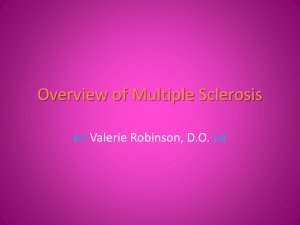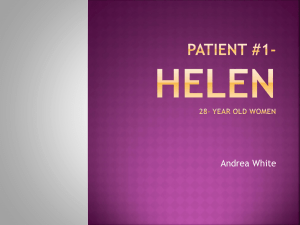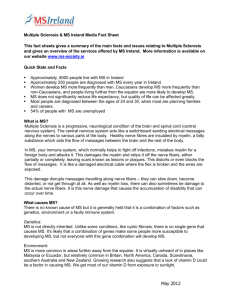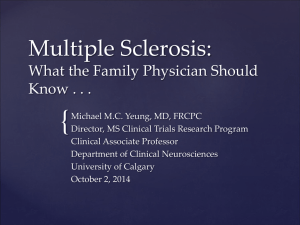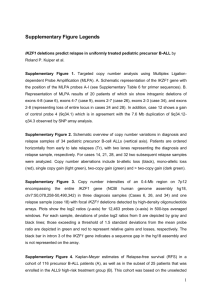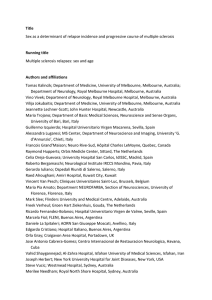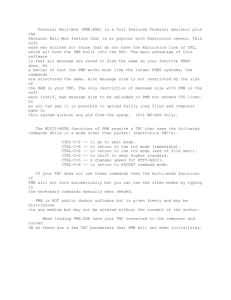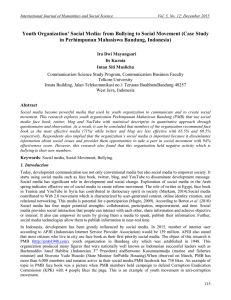Multiple Sclerosis - Council for Medical Schemes
advertisement
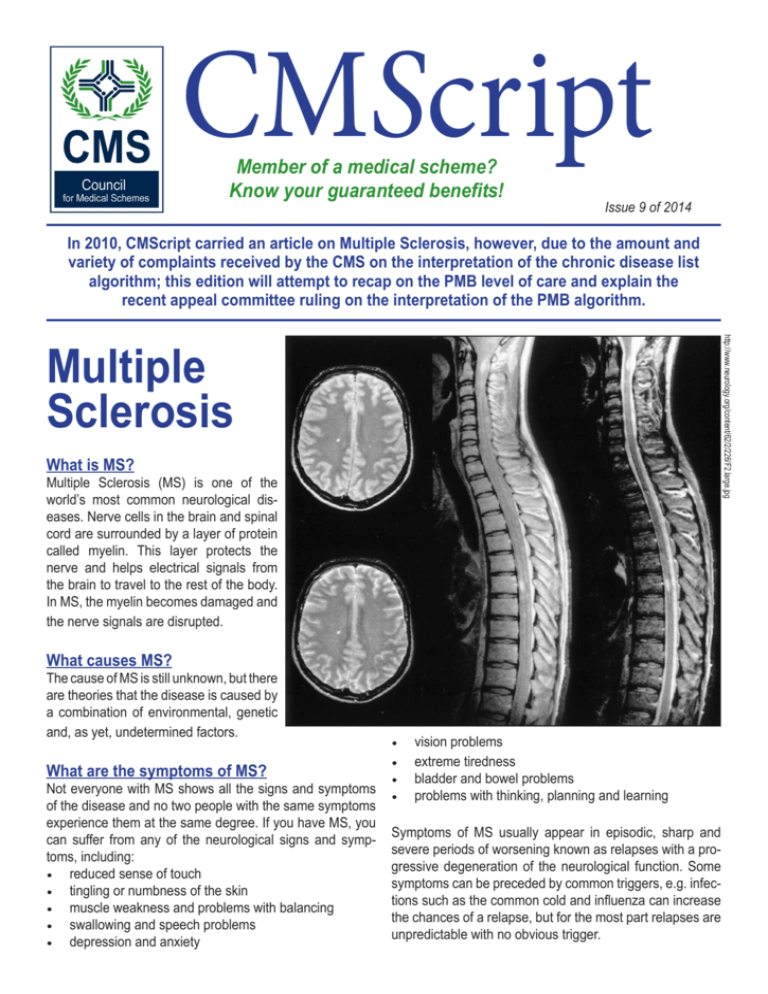
CMScript Member of a medical scheme? Know your guaranteed benefits! Issue 9 of 2014 In 2010, CMScript carried an article on Multiple Sclerosis, however, due to the amount and variety of complaints received by the CMS on the interpretation of the chronic disease list algorithm; this edition will attempt to recap on the PMB level of care and explain the recent appeal committee ruling on the interpretation of the PMB algorithm. http://www.neurology.org/content/62/2/226/F2.large.jpg Multiple Sclerosis What is MS? Multiple Sclerosis (MS) is one of the world’s most common neurological diseases. Nerve cells in the brain and spinal cord are surrounded by a layer of protein called myelin. This layer protects the nerve and helps electrical signals from the brain to travel to the rest of the body. In MS, the myelin becomes damaged and the nerve signals are disrupted. What causes MS? The cause of MS is still unknown, but there are theories that the disease is caused by a combination of environmental, genetic and, as yet, undetermined factors. What are the symptoms of MS? Not everyone with MS shows all the signs and symptoms of the disease and no two people with the same symptoms experience them at the same degree. If you have MS, you can suffer from any of the neurological signs and symptoms, including: • reduced sense of touch • tingling or numbness of the skin • muscle weakness and problems with balancing • swallowing and speech problems • depression and anxiety • • • • vision problems extreme tiredness bladder and bowel problems problems with thinking, planning and learning Symptoms of MS usually appear in episodic, sharp and severe periods of worsening known as relapses with a progressive degeneration of the neurological function. Some symptoms can be preceded by common triggers, e.g. infections such as the common cold and influenza can increase the chances of a relapse, but for the most part relapses are unpredictable with no obvious trigger. http://www.guyanatimesgy.com/wp-content/uploads/2013/04/MRI-1.jpg 2 Who is affected? Diagnostic tests that will be performed and that are includMS is more likely to occur in women. The average age for ed in the PMB regulations are: onset is the early thirties. The disease is more common • Neurological examination among white people, in particular across the northern parts • Blood tests to rule out other conditions that cause symptoms similar to those of MS, including lupus eryof Europe and North America. It is less common in the tropithematosis, Sjogrens, vitamin and mineral deficiencies, cal areas of the world. some infections, and rare hereditary diseases • Spinal tap or lumbar puncture to check for abnormaliWhat are the types of MS? ties associated with multiple sclerosis, such as abnor• Remitting Relapsing Multiple Sclerosis (RRMS) is the mal levels of white blood cells or proteins most common of the four types of MS and is charac• MRI scan of the brain and spinal cord terised by unpredictable relapses followed by months to years of relative quiet (remission) with no new signs • Evoked potential test – this test measures electrical signals sent by your brain in response to stimuli of disease activity. • Secondary Progressive Multiple Sclerosis (SPMS) describes a form of MS where a patient begins a progres- There is no cure for MS, but treatments can relieve sympsive neurological decline between acute attacks with toms and reduce the number of relapses. If your symptoms are mild, you may not need treatment unless you experivery few periods of remission. • Primary Progressive Multiple Sclerosis (PPMS) de- ence a relapse. scribes a type of MS where symptoms steadily progress following the initial attack and disability develops Treatment for MS can be split into three categories: at a relatively early stage. PPMS is characterised by • treatment for relapses of MS symptoms (steroids) the progression of disability from the onset, with no, or • treatment for specific MS symptoms only occasional and minor, remissions and improve- • treatment to reduce the number of relapses (diseasemodifying medicines) ments. • Clinically Isolated Syndrome (CIS) describes an inDisease modifying medicines and immunomodulatory therstance where patients suffer one attack. apy – which induces, enhances, or suppresses immune responses, includes beta-interferons. Diagnosis, treatment, and care covered by PMBs? The diagnosis of MS is based on the McDonald criteria. The definition of a relapse as based on the McDonald criteria indicates that a relapse lasts at least 24 hours, it is not a pseudo-attack, and at least 30 days pass before the next relapse occurs. The PMB algorithm specifies that in cases of Frequent relapse OR Secondary progressive disease, treatment with beta-interferon should be considered. Frequent relapse Secondary progressive Medical schemes interpreted that the PMB algorithm indicated that frequent relapse AND secondary progressive disease must be present in order for beta-interferon to be funded as PMB level of care. The Appeals Committee of the Council for Medical Schemes ruled on this complaint and found that: result from damage in the central nervous system that reduces control of the muscles used in these important functions. The goal of therapy is to improve ease and clarity of communication as well as promote safe swallowing and overall health. Some SLPs also evaluate and treat problems with thinking and memory. 3 • The primary rule of interpretation is to give the meaning of the words their plain ordinary grammatical meaning unless the words are ambiguous, vague, misleading or if a strict literal interpretation would lead to absurd results. • The Appeals Committee reviewed various dictionaries and found that since both terms begin with a capital letter and the punctuational use of a capital letter is to distinguish separate sentences and phrases, the ordinary grammatical meaning of the words shows that the term “Frequent relapse Secondary progressive” is two separate terms. • As such, beta-interferon can be considered and qualifies as PMB level of care in both Frequent relapse OR Secondary progressive disease. • The Committee was also of the view and that the literal meaning of the words are not ambiguous, vague, misleading nor lead to absurd results. These rehabilitation services are considered PMB level of care. However, as the condition is a progressive disease, ongoing therapy must focus on assessment of functioning and providing training in techniques that the member can implement at home. It is therefore important that the therapists transfer the skills to the member and the primary care giver so that it is not necessary for the member to receive all therapy and exercises at the therapist’s rooms. Members must be able to continue with the therapy at home and only consult with the therapist for progress evaluation and in cases where there is deterioration of the condition and new functioning techniques are required. The treatment and care component of MS as a PMB also includes rehabilitation services such as physiotherapy, occupational therapy and speech therapy. Hotline: 0861 123 267 Fax: 012 430 7644 Physiotherapy must focus on walking and mobility, strength, balance, posture, fatigue, and pain. It may include an exercise program, walking and training in the use of mobility aids such as canes, crutches, scooters and wheelchairs. The goal of physiotherapy is to promote safety, achieve and maintain optimal functioning, and prevent unnecessary complications such as de-conditioning, muscle weakness from lack of mobility and muscle contractures related to spasticity. Occupational therapy is provided to improve independence, productivity and safety in all activities related to personal care, employment and leisure activities. Occupational therapists must provide training in energy conservation techniques and the use of adaptive tools and devices to simplify tasks at home and in the office. They can further advice on adjustments to the home and workplace to ensure accessibility and convenience. Occupational therapists also evaluate and treat problems with thinking and memory. Speech/language pathologist (SLP) evaluates and treats problems with speech and/or swallowing, both of which can The Communications Unit would like to thank Dr Nkuli Mlaba and Dr Boshoff Steenekamp, the originators of this Script and Ronelle Smit for assisting with additions. information@medicalschemes.com The clinical information furnished in this article is intended for information purposes only and professional medical advice must be sought in all instances where you believe that you may be suffering from a medical condition. The Council for Medical Schemes is not liable for any prejudice in the event of any person choosing to act or rely solely on any information published in CMScript without having sought the necessary professional medical advice. PMBs Prescribed minimum benefits (PMBs) are defined by law. They are the minimum level of diagnosis,treatment, and care that your medical scheme must cover – and it must pay for your PMB condition/s from its risk pool and in full. There are medical interventions available over and above those prescribed for PMB conditions but your scheme may choose not to pay for them. A designated service provider (DSP) is a healthcare provider (e.g. doctor, pharmacist, hospital) that is your medical scheme’s first choice when you need treatment or care for a PMB condition. You can use a non-DSP voluntarily or involuntarily but be aware that when you choose to use a non-DSP, you may have to pay a portion of the bill as a co-payment. PMBs include 270 serious health conditions, any emergency condition, and 25 chronic diseases; they can be found on our website by accessing the link provided (www.medicalschemes.com/medical_schemes_pmb/index. htm).


